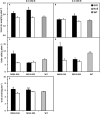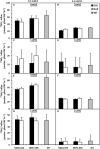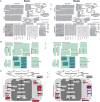Improving Nitrogen Use Efficiency Through Overexpression of Alanine Aminotransferase in Rice, Wheat, and Barley
- PMID: 33584777
- PMCID: PMC7875890
- DOI: 10.3389/fpls.2021.628521
Improving Nitrogen Use Efficiency Through Overexpression of Alanine Aminotransferase in Rice, Wheat, and Barley
Abstract
Nitrogen is an essential nutrient for plants, but crop plants are inefficient in the acquisition and utilization of applied nitrogen. This often results in producers over applying nitrogen fertilizers, which can negatively impact the environment. The development of crop plants with more efficient nitrogen usage is, therefore, an important research goal in achieving greater agricultural sustainability. We utilized genetically modified rice lines over-expressing a barley alanine aminotransferase (HvAlaAT) to help characterize pathways which lead to more efficient use of nitrogen. Under the control of a stress-inducible promoter OsAnt1, OsAnt1:HvAlaAT lines have increased above-ground biomass with little change to both nitrate and ammonium uptake rates. Based on metabolic profiles, carbon metabolites, particularly those involved in glycolysis and the tricarboxylic acid (TCA) cycle, were significantly altered in roots of OsAnt1:HvAlaAT lines, suggesting higher metabolic turnover. Moreover, transcriptomic data revealed that genes involved in glycolysis and TCA cycle were upregulated. These observations suggest that higher activity of these two processes could result in higher energy production, driving higher nitrogen assimilation, consequently increasing biomass production. Other potential mechanisms contributing to a nitrogen-use efficient phenotype include involvements of phytohormonal responses and an alteration in secondary metabolism. We also conducted basic growth studies to evaluate the effect of the OsAnt1:HvAlaAT transgene in barley and wheat, which the transgenic crop plants increased seed production under controlled environmental conditions. This study provides comprehensive profiling of genetic and metabolic responses to the over-expression of AlaAT and unravels several components and pathways which contribute to its nitrogen-use efficient phenotype.
Keywords: RNAseq; alanine aminotransferase; carbohydrate metabolism; nitrogen use efficiency; transgenic cereals.
Copyright © 2021 Tiong, Sharma, Sampath, MacKenzie, Watanabe, Metot, Lu, Skinner, Lu, Kridl, Baumann, Heuer, Kaiser and Okamoto.
Conflict of interest statement
JK was a named inventor on United States Patents Nitrogen-Efficient Monocot Plants US 8642840 and 8288611, and Arcadia Biosciences has exclusively licensed these patents and others concerning the NUE technology described. JK, WS, YL, and ZL are employees of Arcadia Biosciences, Inc. and as such Arcadia partially funded the work described. The remaining authors declare that the research was conducted in the absence of any commercial or financial relationships that could be construed as a potential conflict of interest.
Figures







Similar articles
-
Molecular and phenotypic characterization of transgenic wheat and sorghum events expressing the barley alanine aminotransferase.Planta. 2017 Dec;246(6):1097-1107. doi: 10.1007/s00425-017-2753-1. Epub 2017 Aug 11. Planta. 2017. PMID: 28801748
-
Genetic engineering of improved nitrogen use efficiency in rice by the tissue-specific expression of alanine aminotransferase.Plant Biotechnol J. 2008 Sep;6(7):722-32. doi: 10.1111/j.1467-7652.2008.00351.x. Epub 2008 May 27. Plant Biotechnol J. 2008. PMID: 18510577
-
Transcriptome analysis of nitrogen-efficient rice over-expressing alanine aminotransferase.Plant Biotechnol J. 2009 Aug;7(6):562-76. doi: 10.1111/j.1467-7652.2009.00424.x. Epub 2009 Jun 8. Plant Biotechnol J. 2009. PMID: 19508275
-
Carbon and nitrogen assimilation in relation to yield: mechanisms are the key to understanding production systems.J Exp Bot. 2002 Apr;53(370):773-87. J Exp Bot. 2002. PMID: 11912221 Review.
-
[Research advance in nitrogen metabolism of plant and its environmental regulation].Ying Yong Sheng Tai Xue Bao. 2004 Mar;15(3):511-6. Ying Yong Sheng Tai Xue Bao. 2004. PMID: 15228008 Review. Chinese.
Cited by
-
Improving crop productivity and nitrogen use efficiency using sulfur and zinc-coated urea: A review.Front Plant Sci. 2022 Oct 14;13:942384. doi: 10.3389/fpls.2022.942384. eCollection 2022. Front Plant Sci. 2022. PMID: 36311059 Free PMC article. Review.
-
Crop genetic diversity uncovers metabolites, elements, and gene networks predicted to be associated with high plant biomass yields in maize.PNAS Nexus. 2022 Jul 4;1(3):pgac068. doi: 10.1093/pnasnexus/pgac068. eCollection 2022 Jul. PNAS Nexus. 2022. PMID: 36741443 Free PMC article.
-
Biofortification as a solution for addressing nutrient deficiencies and malnutrition.Heliyon. 2024 May 1;10(9):e30595. doi: 10.1016/j.heliyon.2024.e30595. eCollection 2024 May 15. Heliyon. 2024. PMID: 38726166 Free PMC article. Review.
-
The recent genetic modification techniques for improve soil conservation, nutrient uptake and utilization.GM Crops Food. 2024 Dec 31;15(1):233-247. doi: 10.1080/21645698.2024.2377408. Epub 2024 Jul 15. GM Crops Food. 2024. PMID: 39008437 Free PMC article. Review.
-
Role of alanine aminotransferase in crop resilience to climate change: a critical review.Physiol Mol Biol Plants. 2024 Dec;30(12):1935-1953. doi: 10.1007/s12298-024-01540-8. Epub 2024 Dec 11. Physiol Mol Biol Plants. 2024. PMID: 39744323 Free PMC article. Review.
References
-
- Ashhurst D. E. (2001). Chitin and chitinases. Cell Biochem. Funct. 19 228–228. 10.1002/cbf.916 - DOI
-
- Ashraf M., Foolad M. R. (2007). Roles of glycine betaine and proline in improving plant abiotic stress resistance. Environ. Exp. Bot. 59 206–216. 10.1016/j.envexpbot.2005.12.006 - DOI
-
- Beatty P. H., Carroll R. T., Shrawat A. K., Guevara D., Good A. G. (2013). Physiological analysis of nitrogen-efficient rice overexpressing alanine aminotransferase under different N regimes. Bot. Botanique 91 866–883. 10.1139/cjb-2013-0171 - DOI
LinkOut - more resources
Full Text Sources
Other Literature Sources

